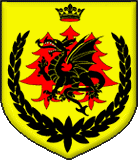
A Midsummer Behourdium & Deeds of Arms
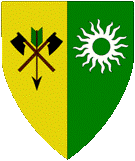
Behourdium Home | Create the Feel of 15th Cent tournament | Rene d'Anjou | Credits
How to create the feeling of a 15th Century Tournament
This section is based a lot on the text ‘How a Man Shall Prepare Himself for the Tournament’ by Will McLean. The authors permission to use this text has been granted for a previous version of this booklet. The original text can be found on the web at http://mqh.cit.cornell.edu/~mqh/st-mikes/tourney.html. Here are some suggestions that may be useful if you want to contribute to create a feeling of a fifteenth century tournament.
Your ArrayFirst, examine your harness. Is it of one consistent period? Can you find a picture of a medieval Knight that looks like you do? Are there glaring anachronisms? Few harnesses conceal enough of blue jeans to hide their essential nature. Dark sweat pants, with socks in a matching color, are better and hose are better still. Two-tone Nikes (or tennis shoes) don't look very medieval. All black sneakers are better, and medieval shoes or sabatons are better still. The right covering can conceal a multitude of sins. Essentially, you have two approaches. Before 1350, the armor was less challenging, but the surcoats were usually sleeveless, so they covered less of it. When sleeves were worn, they were rarely longer than elbow length. After 1350, the armor was more sophisticated, but garments called jupons or coat-armors, often with long sleeves, sometimes covered much of it. From 1400 on uncovered plate armor became increasingly popular. The later a period you choose, the more dependent you become on a good armorer. |
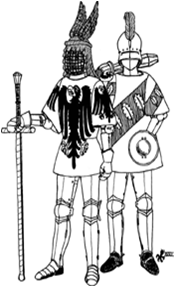
|
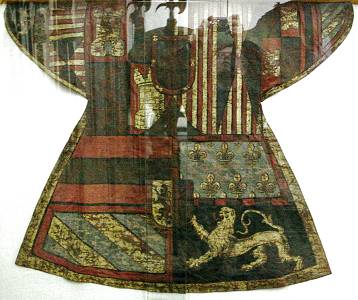
|
The fighter’s tabardAccording to King René’s manual, the fighters should wear a short tabard displaying the fighter’s device. The tabards shown in the manual are of the same type as the Burgundian heralds tabards, see picture. The device should be shown both on the front and the back of the tabard, as well on both sleeves. The tabard should reach to mid-thigh when worn over the armour. Remember to make the tabard ca. 5-6 cm longer at the back. Carrying Your HelmetThe ideal way to carry your helmet is on a short pole. This is convenient, elevates your crest so people can see it better, and keeps oil off your hands and sweat off the helmet. King Rene recommends a length of lance-shaft as long as your arm. Lengths of broken lance shaft must have filled the same ecological niche then that pieces of broken rattan too short to turn into a decent sword do today. After a day's jousting they must have been knee deep in the stuff. |
|
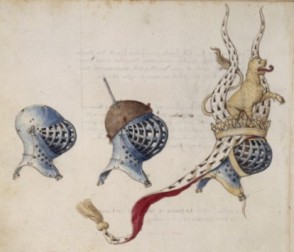
|
Your Retinue
From the 14th century on, great persons often equipped their followers in livery, that is distinctive clothing, either of distinctive colours of fabric, or distinguished by badges, or both. The colours might be the same as the lord's arms, or they might not, and the colours of clothing delivered to the lords followers might vary from year to year depending on the whim of the lord, the availability of fabric, and so on.
Liveries were often parti-coloured, and sometimes tri-coloured. The colours were not restricted to the pure colours of heraldry. Other options included light green, tawny (orange-brown), russet (rusty redbrown) and murrey (purple-red, or mulberry colour). Liveries might consist of complete suites of clothing, sleeveless jackets, or sometimes simply hoods.
Badges might be made from metal, appliqued, or embroidered. Popular locations included upon the sleeve or hat, the middle of the chest and back, or upon what would now be the lapel, usually on the wearer's left side.
A noble that really wanted to show off at a tournament would put his retinue not simply into matching clothes, but into elaborate costumes. Besides the examples mentioned earlier, Claude de Vauldrey came to one 15th c. Burgundian tournament with a retinue of wildmen and wildwomen. Another had costumed Moors in his train.
This does present some opportunities for people with personas that aren't your standard late-Middle Ages West-European types. A Celt might come as "The King of Lyonesse" with a retinue in fringed cloaks, carrying Irish javelins. A Berber from the Maghreb might be followed by turbaned Moors with nakers and kettledrums. (A real 15th century Burgundian doing this would of course try to find an elephant or pair of camels to add to the procession. Camels and elephants are also available for hire in modern Europe...)
The ideal thing would be to really push it over the edge, so that instead of just being a SCA fighter with knotwork on your shield, you look like a Burgundian that decided it would be impressive to outfit his entire following in Arthurian fancy dress.
The greater nobles would often bring several men-at-arms as part of their following, to fight beside them in the tourney.
For this tourney however, we have limited the number of followers (see Special Rules).

|
The BannerThe banner was about two to three feet square, or if rectangular, about two to three feet deep, and with a width about two thirds of the depth. The earlier banners tended to be rectangular rather than square. Sometimes the banner was fringed with the livery colours. The arms were displayed on the whole surface of the banner, with the dexter side always in the hoist. Don't assume that your choices are embroidery or nothing. Medieval banners were often painted. If you are making a banner for this tournament we suggest that you make it rectangular, two by three feet (60 cm by 90 cm) since this seems to be consistent with what is shown in King René's tournament book. Banners were not the gonfannons so often seen in the Society (that is, a flag hanging from a horizontal crossbar attached to a central pole), but like modern flags, except for their proportion. If you want a crossbar, here one way to have one. Drill a hole through your pole perpendicular to its length, as close to the end as you can and just large enough to accept a dowel by press fit. Make your banner with a casing for the pole, and a narrower casing for the dowel. Leave the dowel casing open at both ends, and make the dowel casing open into the pole casing. You can now use your banner with or without the support dowel. Or, with a longer dowel, you can hang the banner flat against the wall without the pole. |
A Personal Herald
To uphold your dignity properly, to make your challenges and announce your entry, a personal herald is a fine thing. A personal herald should wear a tabard or coat armour with your device on it. There are many who would covet such a position as an escape from interminably droning: "Salute-the-Crowns-of-Drachenwald-and-theone-who’s-favour-you-wear..." Even more would take the job if you paid them. Seriously, field heralds live for this kind of stuff , and the right one can be a great help with your challenges. Besides, it's so hard to be heard from inside your helmet.
Your Cry
Proper 14th and 15th century nobles had a war cry or motto that they and their retinue could shout in battle or during a tournament. Their fans could shout it from the sidelines too (Seriously. It's all in King Rene's book.)
A cry could be based on a name ("a Chandos! a Chandos!"), a place ("Guienne!") a patron saint ("Notre Dame!") or a combination of these elements ("Montjoie et St. Denis!). We will assume that if your cry contains the name of a saint you are not calling on supernatural aid to assure victory (which the Society frowns on) but asking the saint's aid to fight fairly and honorably (and who could object to that?)
A Display Shield
A small wooden shield will be useful during the Helmschau. The size of the shield should be that of an A4 (or 8 ½ x 11) sized paper that you cut down to a shield shape. (The top edge of the shield should be as wide as the paper). Make the shield out of plywood, hardboard or particleboard, and paint your device on it. The last two look like gessoed wood if you paint both front and back, and give a good smooth surface for painting.
Luckily, this is exactly the size and shape of shield which the kind organisers of the Twenty Year event have offered to make for fighters.
Continue for information on Rene d'Anjou (who gave us such excellent information on 15th century tournaments!)